HTC One max Review - It's Huge
by Brian Klug on October 28, 2013 10:00 AM EST- Posted in
- Smartphones
- HTC
- Mobile
- One
- Snapdragon 600
- Android 4.3
- One max
The performance section is probably a good place to talk about one of the elephants in the room, and that’s the SoC inside the One max. The One max includes a Snapdragon 600 APQ8064T SoC, which consists of 4 Krait 300 cores running at up to 1.7 GHz, and Adreno 320 GPU, all built on TSMC’s 28nm LP process. This is the same SoC that shipped in the original HTC One, and the same 1.7 GHz bin as well. There have been three major variants or families of APQ8064(T) to date. There first was the option for the earliest 1.5 GHz Snapdragon S4 Pro version (AA suffix), the 1.7 GHz “8064T/Pro” variant in the HTC One and One max (AB suffix) which began the Snapdragon 600 branding, and finally the 1.9 GHz CPU and 450 MHz GPU variant we first saw in the SGS4 (AC suffix). Qualcomm usually has a number of revisions of its silicon, and with APQ8064 we saw quite a few. As an aside, expect similar with 8974 or Snapdragon 800.
There’s nothing wrong with the 1.7 GHz Snapdragon 600 variant, it was and still is a great performer, but the reality is that HTC falls behind on its hardware platform with the One max by not going to Snapdragon 800 (MSM8974) like the rest of the competition (Note 3, ASUS Padfone Infinity 2014, LG G2, Nexus 5, and so on). So much of the SoC performance and power story right now is gated by process, and 8974 moves to TSMC’s high-k metal gate 28nm HPM process which affords some clock headroom (up to 2.3 GHz) and lower power consumption at lower performance states for Krait 400 (which is essentially 300 implemented on that new process). 8974 also brings a beefier Adreno 330 GPU with more ALUs and higher clocks, in addition to the new modem IP block, but I won’t go over all of that.
It’s pretty obvious to me that the One max stays with the same SoC used in the original One for a few reasons which ultimately boil down to cost and margin. It obviously means HTC can share the same SoC between the One and One max, and since it’s later in APQ8064’s lifespan I would suspect HTC was able to secure good pricing for it. Having closer shared hardware platform means about the same software stack on top of it, and the same source tree from Qualcomm (BSP) for building and testing ROMs. This makes the software maintenance and update costs lower for the One max. I won’t speculate too much beyond that, but I wouldn’t be surprised if the One max started out an 8974 device but later became an 8064 device, given its timing.
| I Can't Believe I Have to Regularly Update This Table | |||||||||||
| Device | SoC | Cheats In | |||||||||
| 3DM | AnTuTu | AndEBench | Basemark X | Geekbench 3 | GFXB 2.7 | Vellamo | |||||
| ASUS Padfone Infinity | Qualcomm Snapdragon 800 | N | Y | N | N | N | N | Y | |||
| HTC One | Qualcomm Snapdragon 600 | Y | Y | N | N | N | Y | Y | |||
| HTC One mini | Qualcomm Snapdragon 400 | Y | Y | N | N | N | Y | Y | |||
| HTC One max | Qualcomm Snapdragon 600 | Y | Y | N | N | N | Y | Y | |||
| LG G2 | Qualcomm Snapdragon 800 | N | Y | N | N | N | N | Y | |||
| Moto RAZR i | Intel Atom Z2460 | N | N | N | N | N | N | N | |||
| Moto X | Qualcomm Snapdragon S4 Pro | N | N | N | N | N | N | N | |||
| Nexus 4 | Qualcomm APQ8064 | N | N | N | N | N | N | N | |||
| Nexus 7 | Qualcomm Snapdragon 600 | N | N | N | N | N | N | N | |||
| Samsung Galaxy S 4 | Qualcomm Snapdragon 600 | N | Y | Y | N | N | N | Y | |||
| Samsung Galaxy Note 3 | Qualcomm Snapdragon 800 | Y | Y | Y | Y | Y | N | Y | |||
| Samsung Galaxy Tab 3 10.1 | Intel Atom Z2560 | N | Y | Y | N | N | N | N | |||
| Samsung Galaxy Note 10.1 (2014 Edition) | Samsung Exynos 5420 | Y(1.4) | Y(1.4) | Y(1.4) | Y(1.4) | Y(1.4) | N | Y(1.9) | |||
| NVIDIA Shield | Tegra 4 | N | N | N | N | N | N | N | |||
The HTC One max, like a ton of other devices, continues to employ a CPU optimization “boost” feature which plugs in all the CPU cores and increases clocks to their maximum upon detection of certain benchmarks. It’s sad that this needs to be a regular disclosure for each handset release, since the narrative will likely be the same for the near future, but yes the One max does this.
Given product development cycles and how long it takes software in the Android landscape to make it through the chain from internal OEM testing to operator test approval and finally hitting devices, I expect we’ll see a pipeline of devices with this “feature” enabled for a while before it changes, even if we could change every OEM’s mind about it right now. I’m starting to understand more about the origin of these optimizations, the list of APKs they detect and boost for, and what party is ultimately responsible, but that’s a story for another day.
CPU
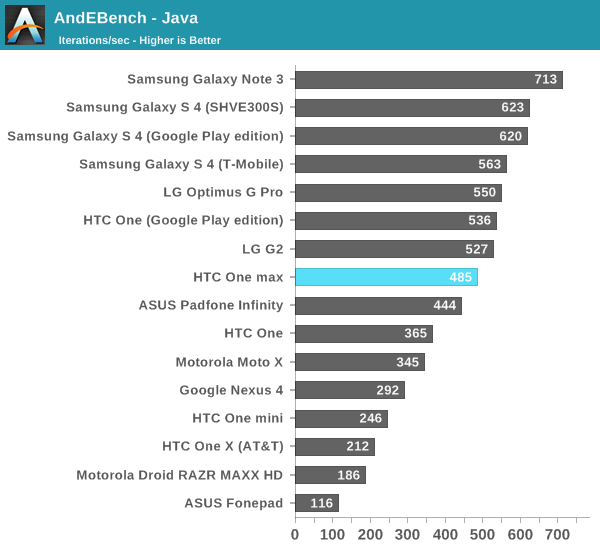
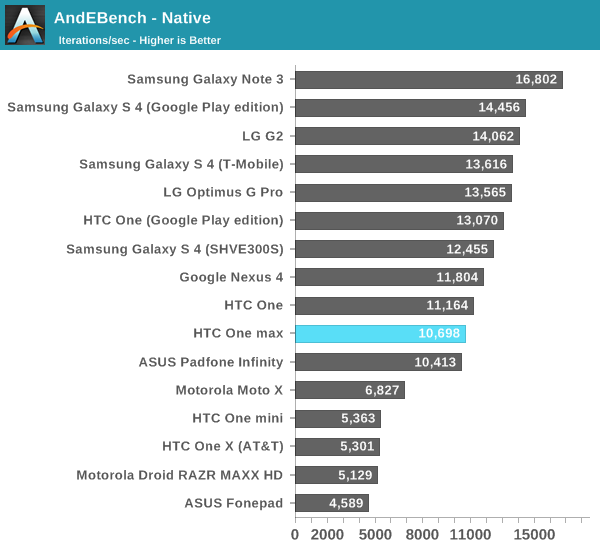
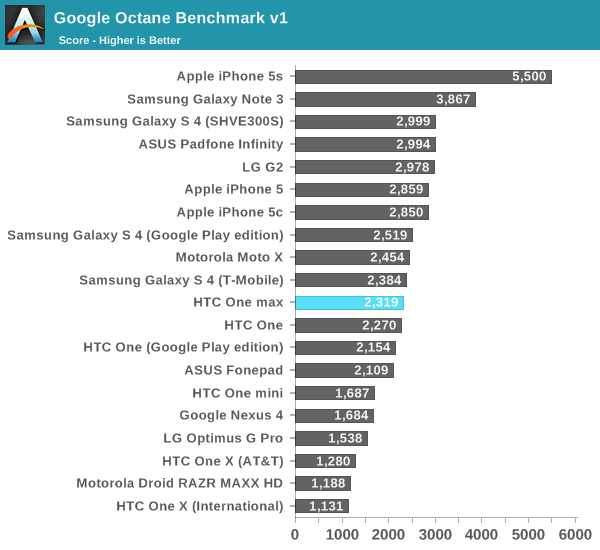
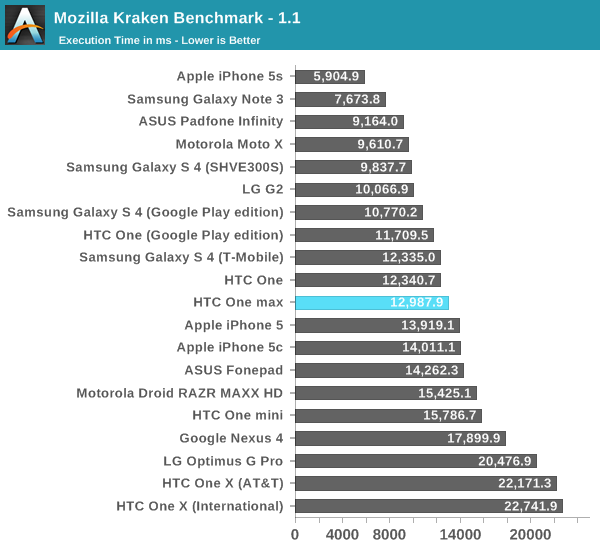
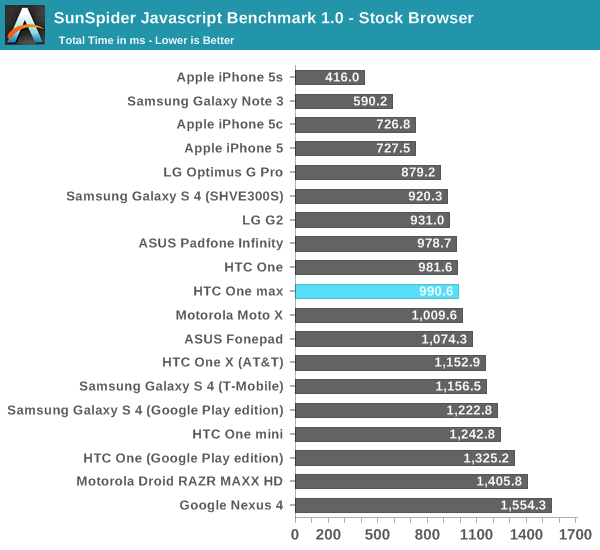
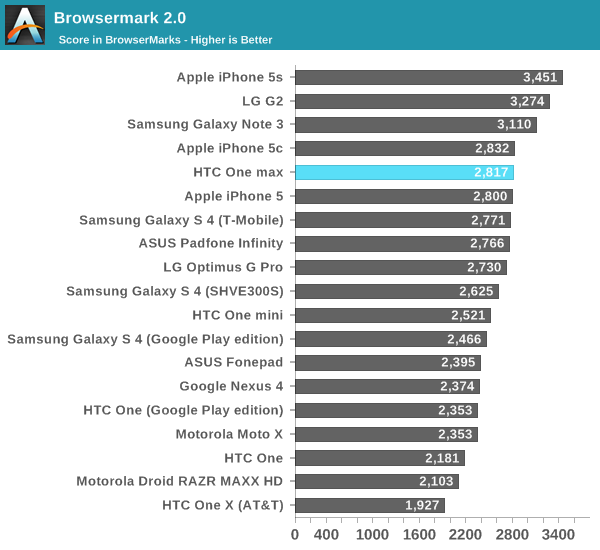
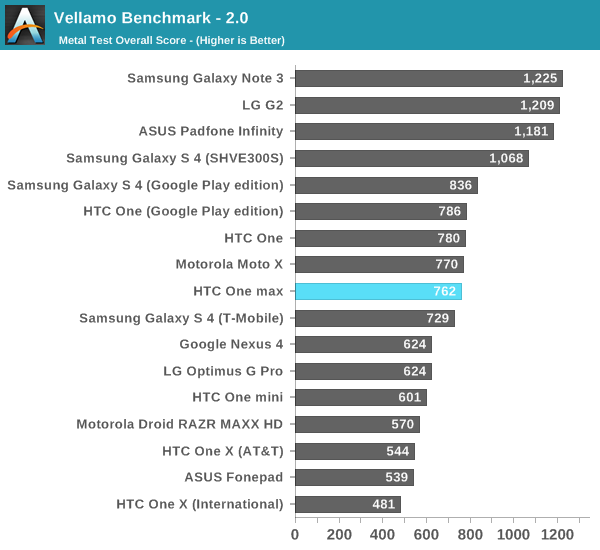
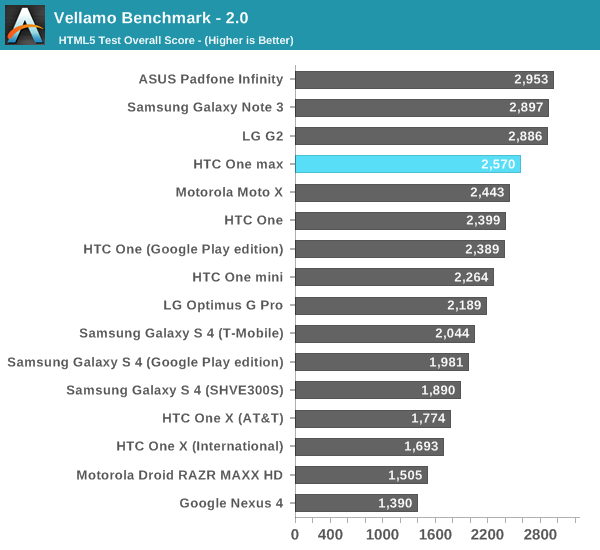
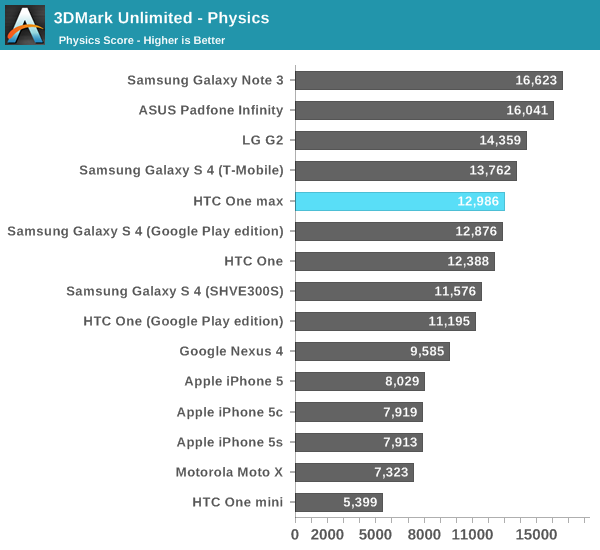
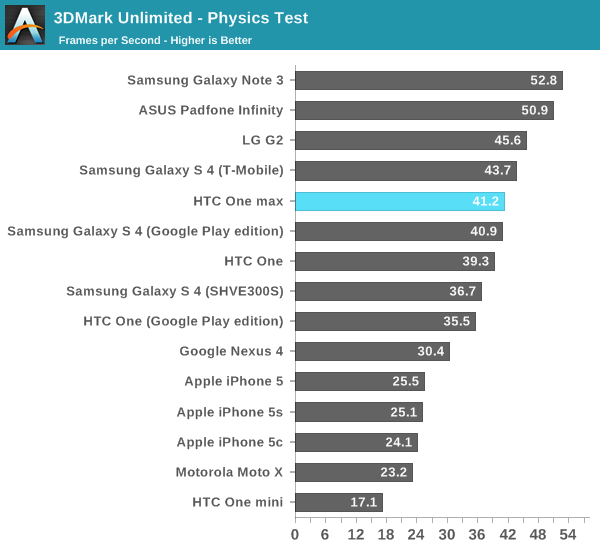
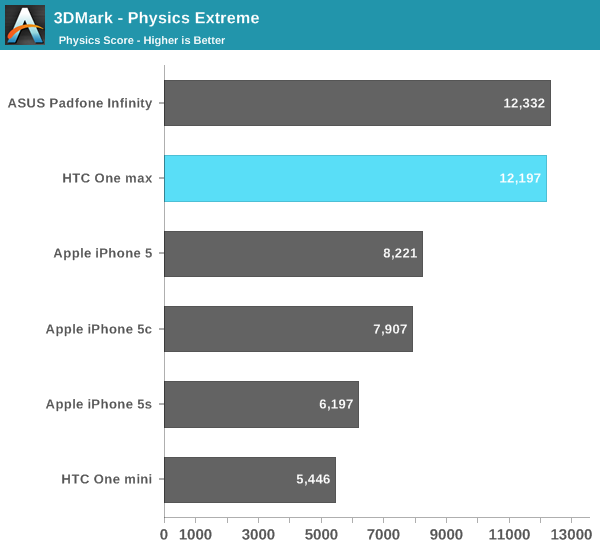
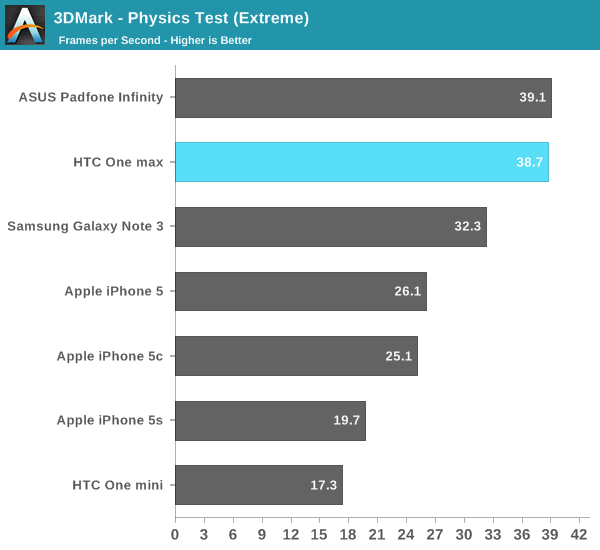
GPU
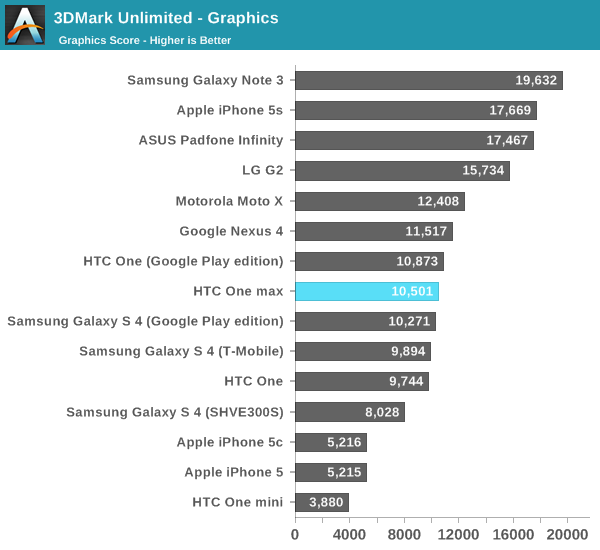
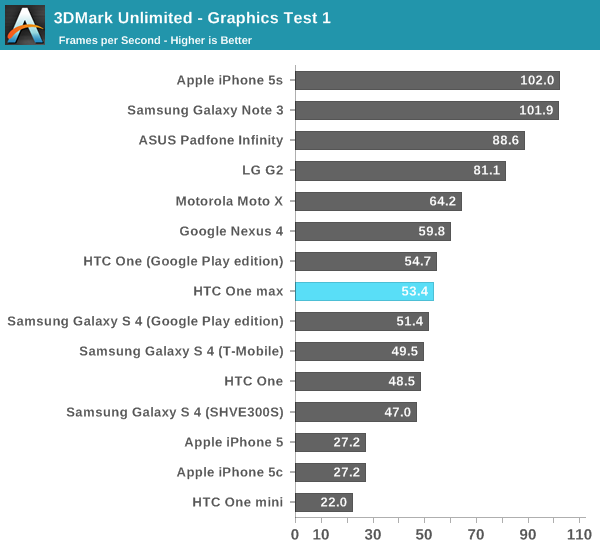
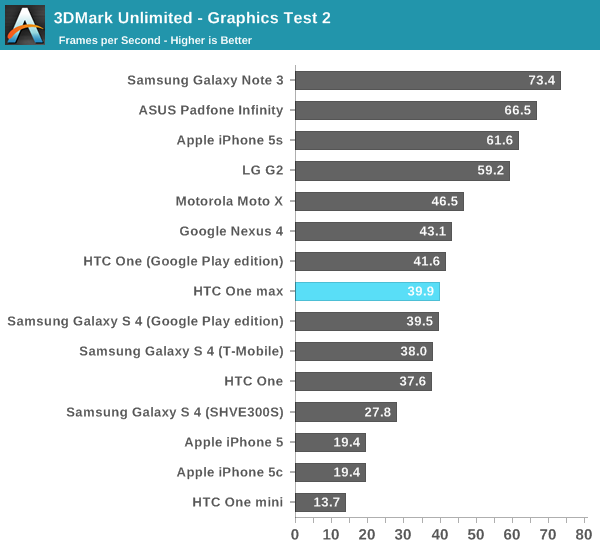
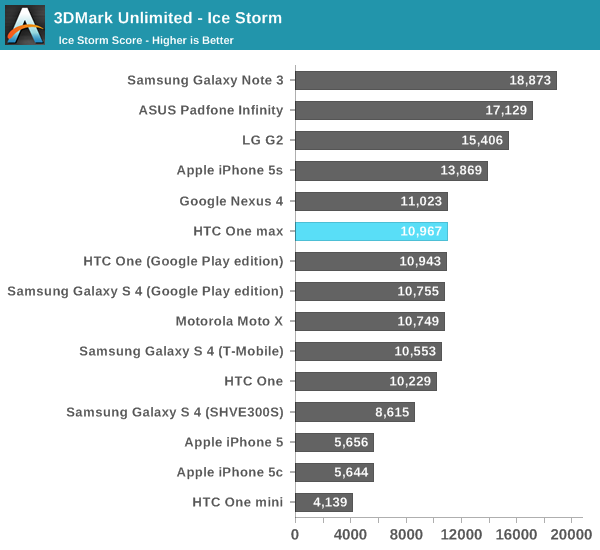
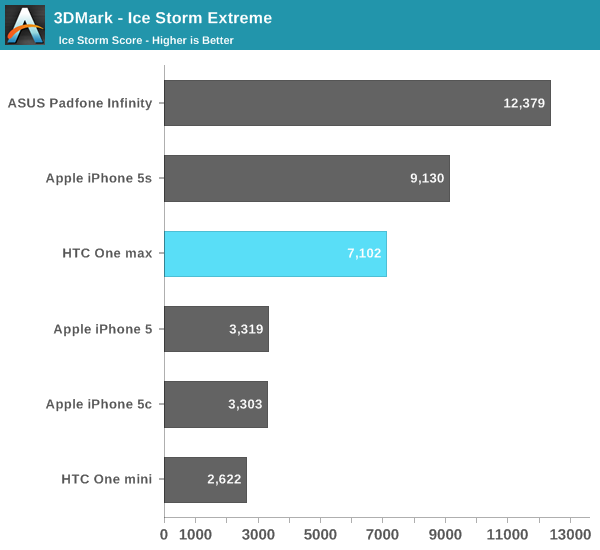
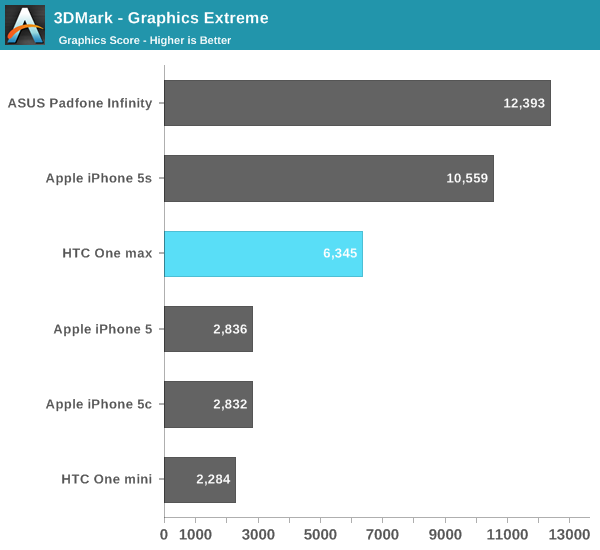
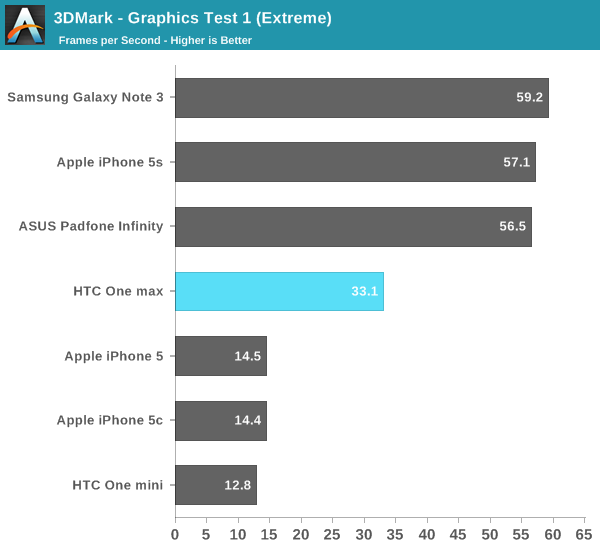
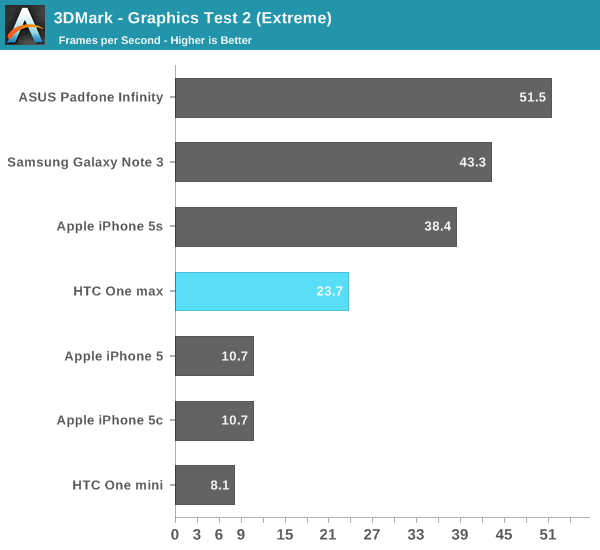
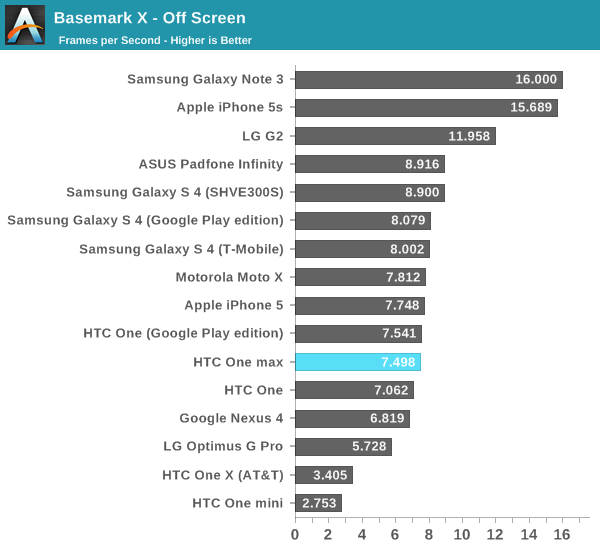
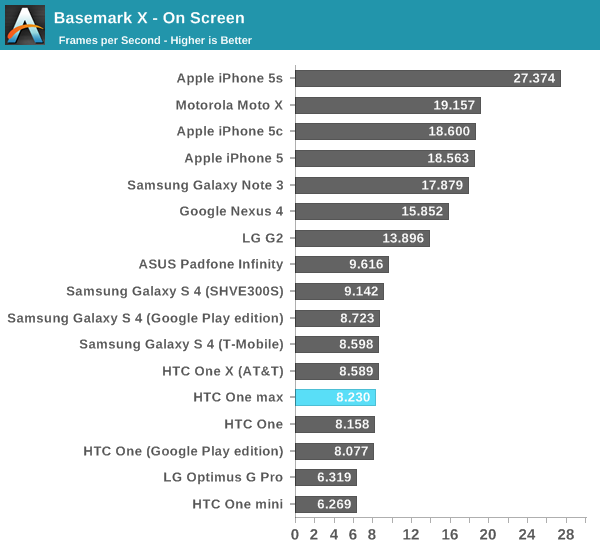
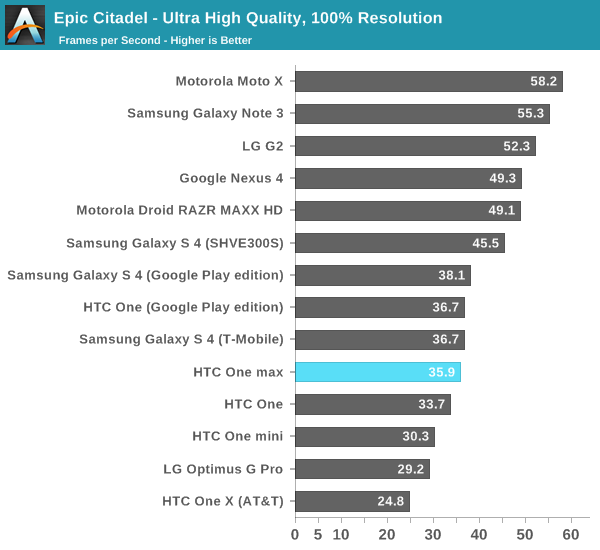
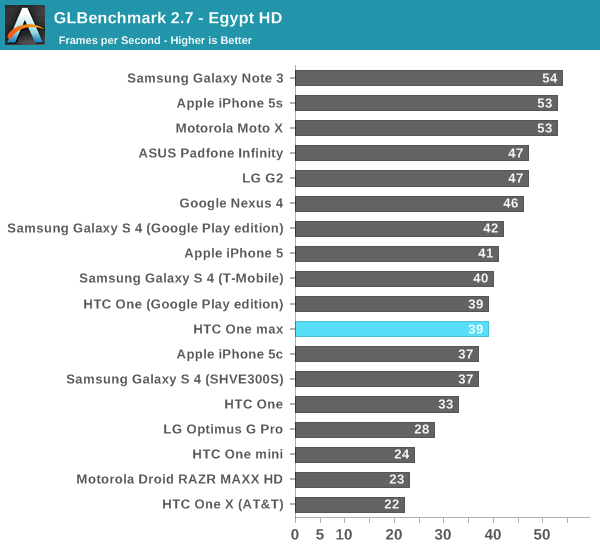
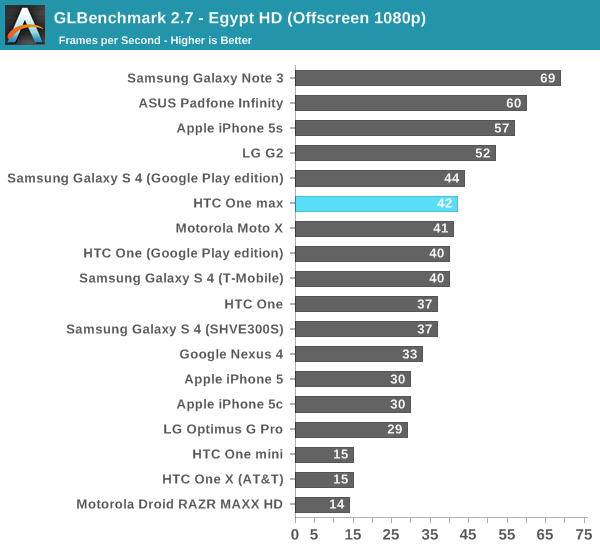
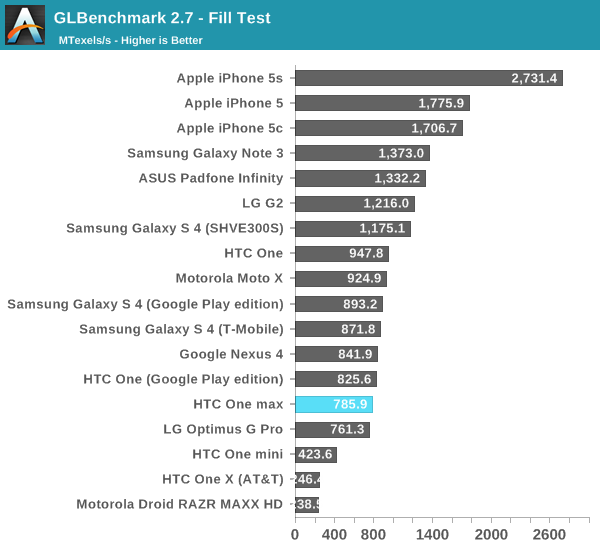

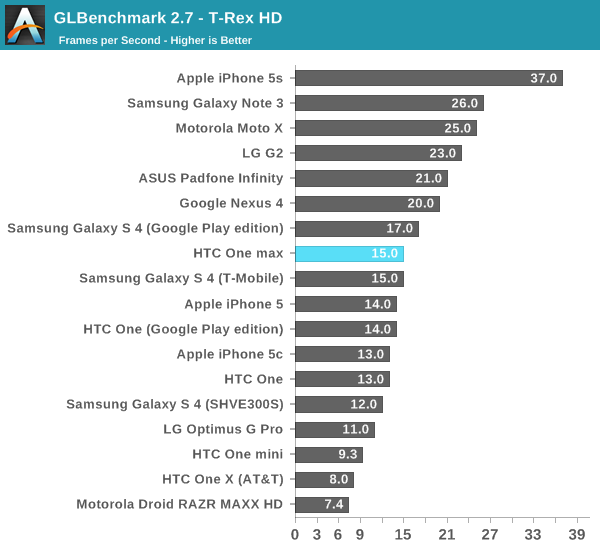
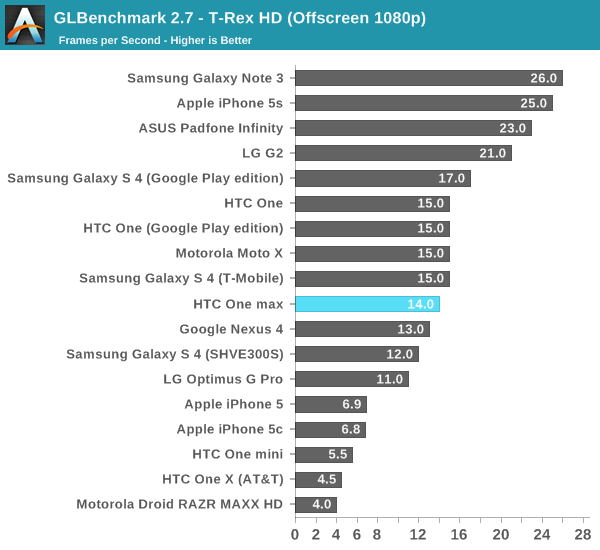
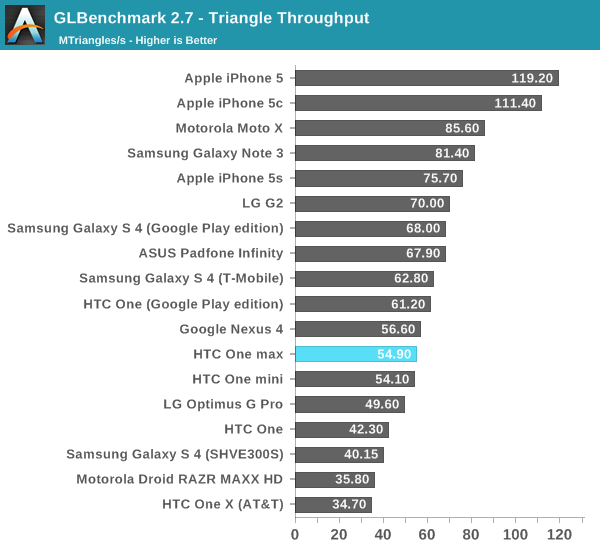
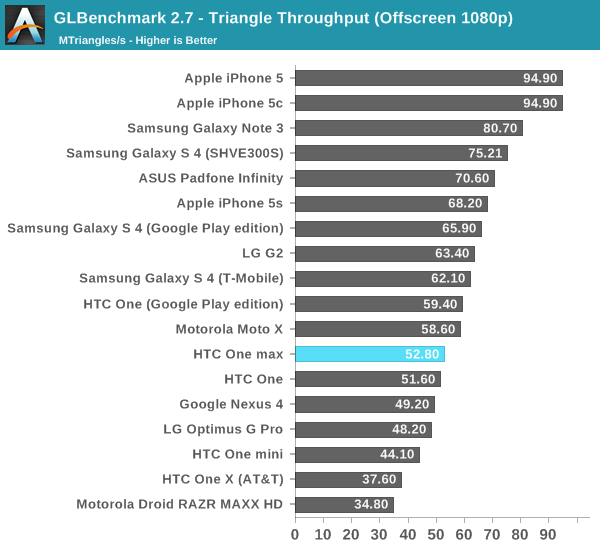
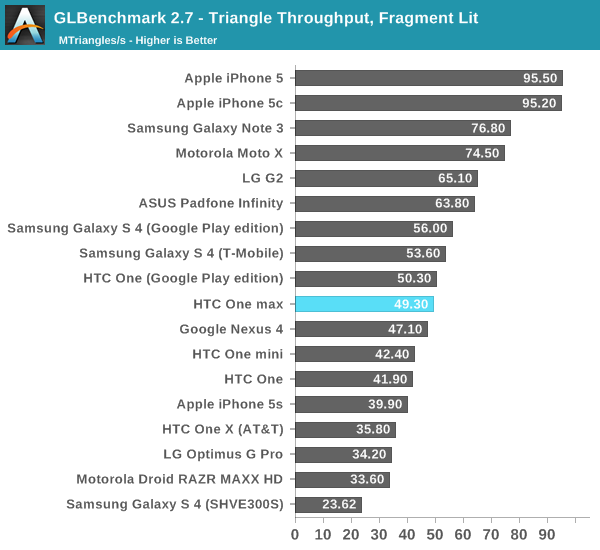
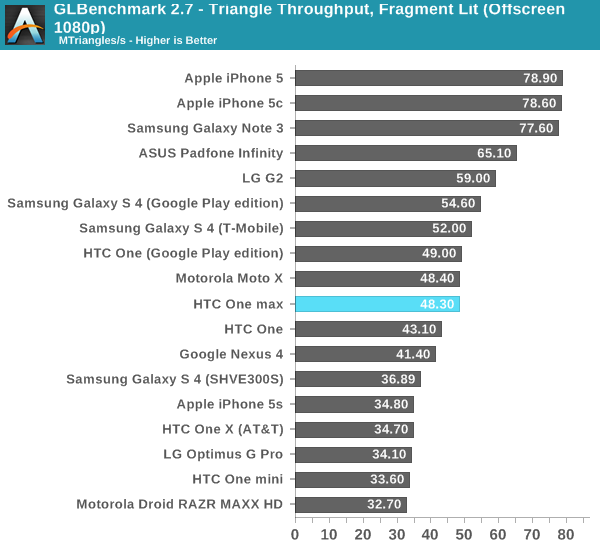
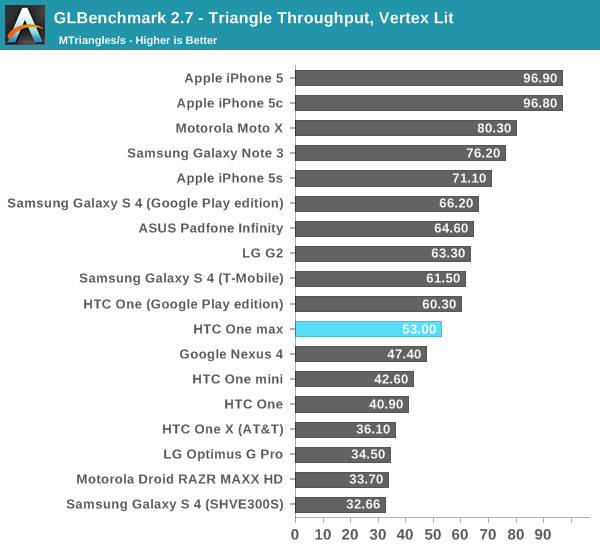
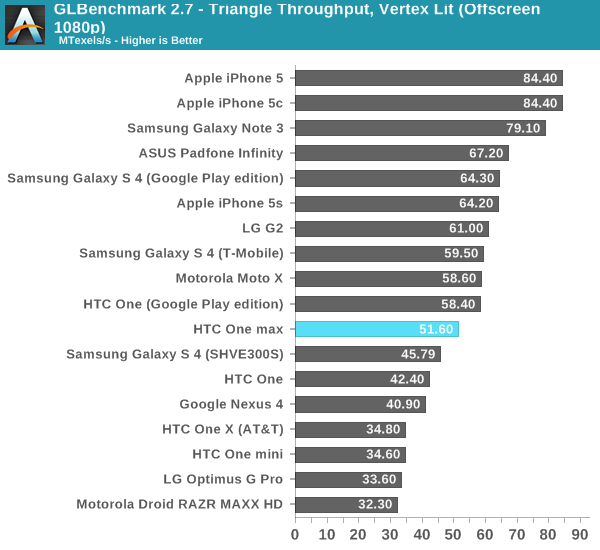
Storage
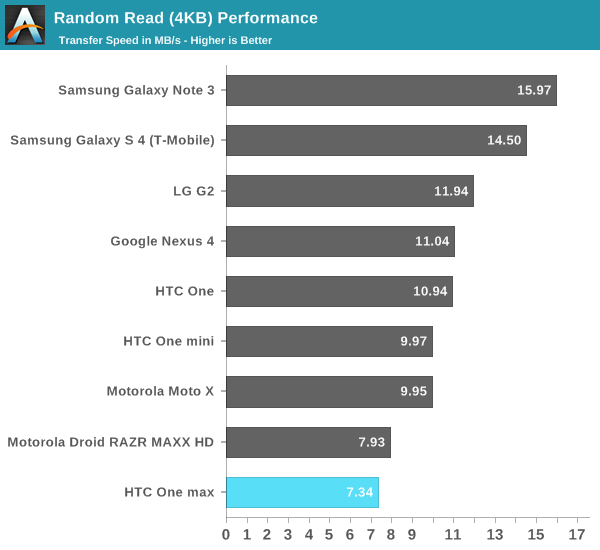
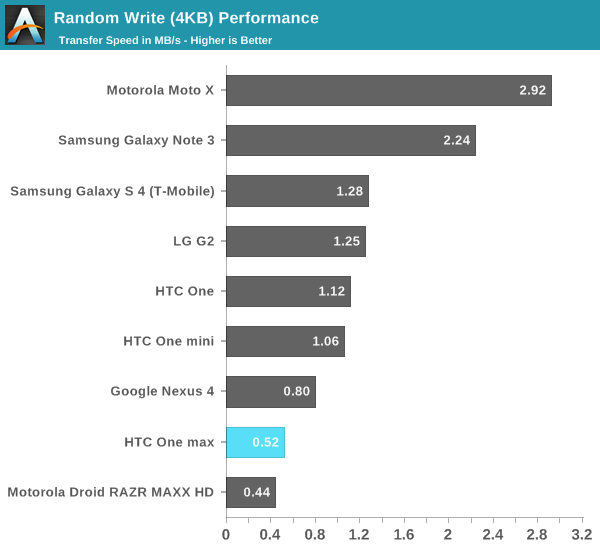
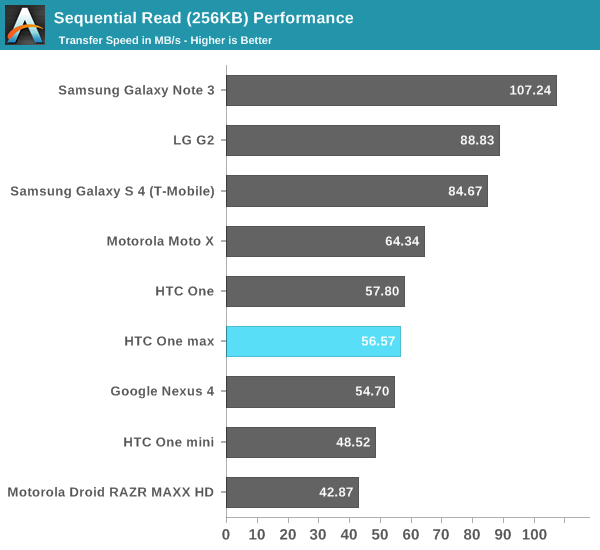
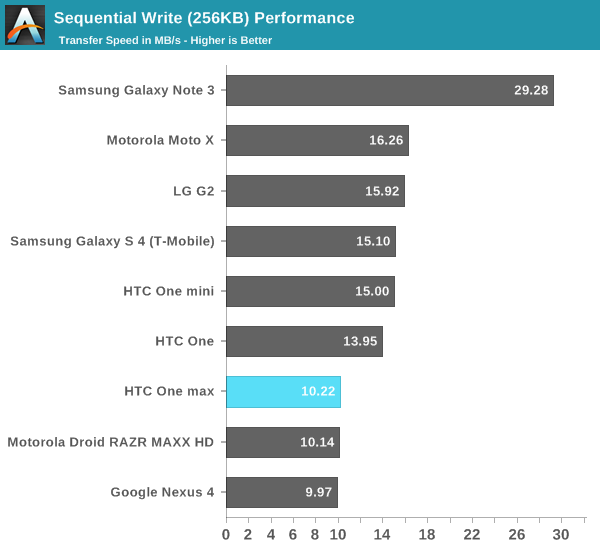
I’m not going to go through all the benchmark results on the One max since again it’s the 1.7 GHz Snapdragon 600 SoC we’re very familiar with at this point. The only oddity is storage performance, where the One max trails in random writes and reads, I'd attribute this to a different eMMC being used. The rest of the results are essentially within the margin of error. I initially suspected that the One max might have a bit more thermal headroom than the One, but this doesn't really seem to play itself out in the results, possibly due to the removable back door.


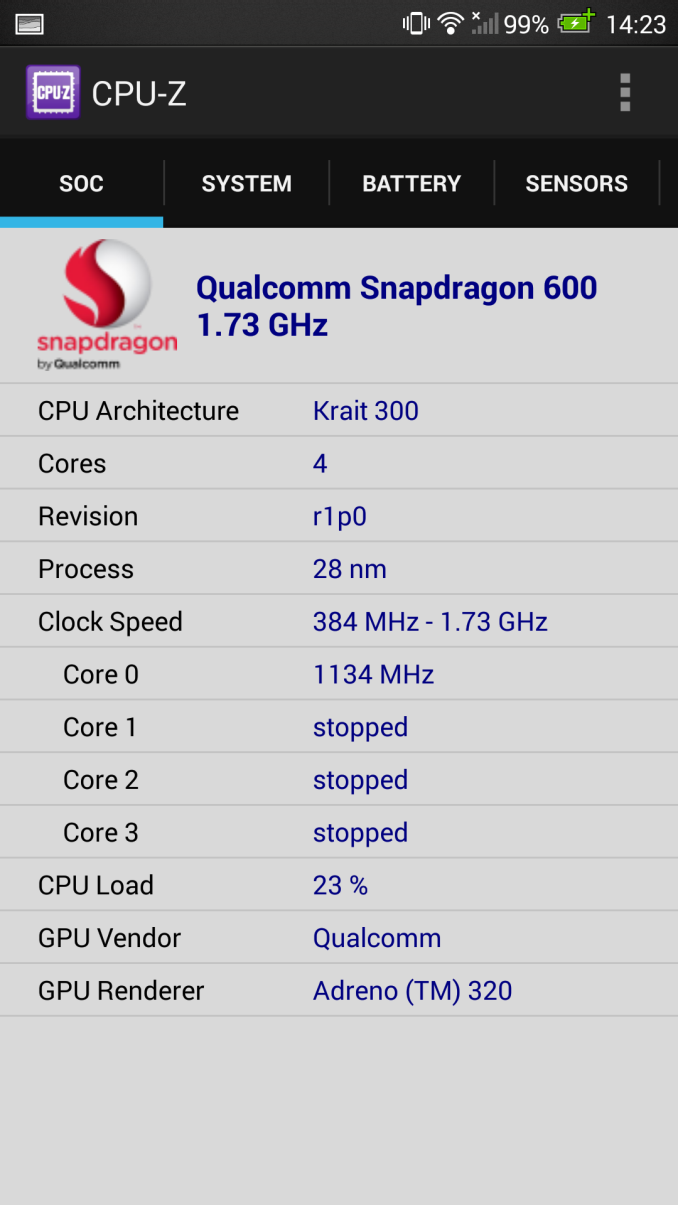
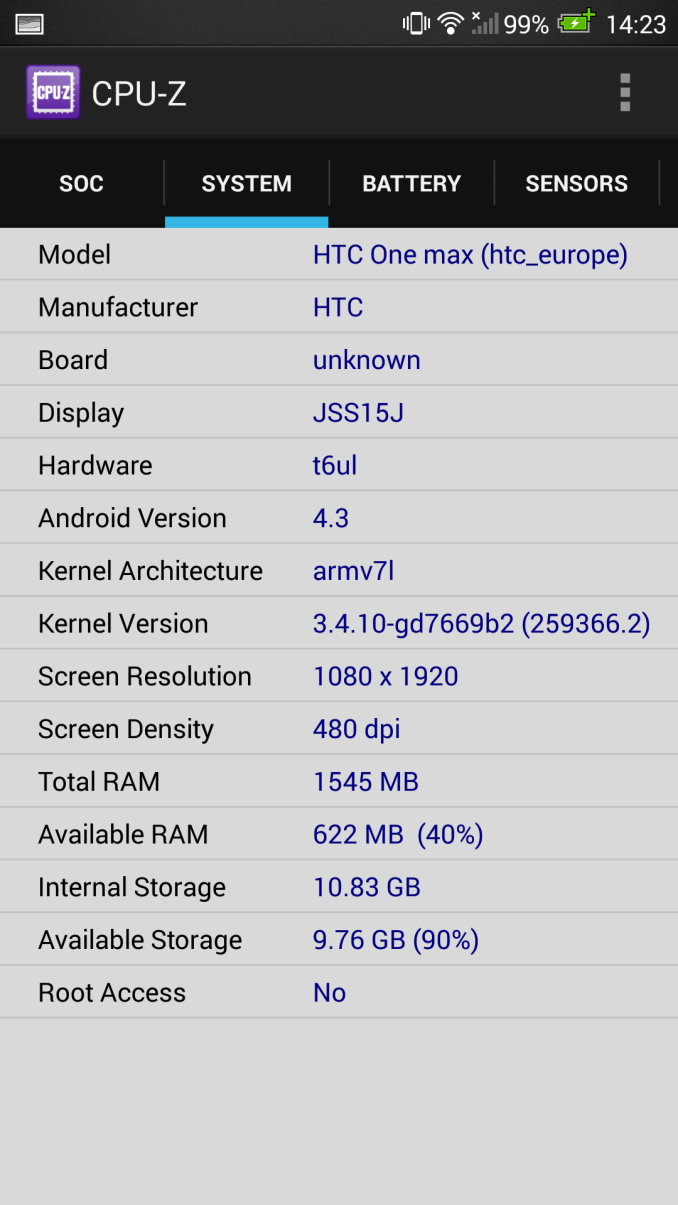








197 Comments
View All Comments
dawp - Tuesday, October 29, 2013 - link
please allow us to flag these spammers on the front page like we can in the forumsmregan - Tuesday, October 29, 2013 - link
Brian,Did you notice the problem that Zoes included in a highlight video now only show 1 second of motion and then freeze? I've seen that one my One when I upgraded to 4.3 and others have reported the same issue. It really seems like a bug. The highlights become much more static. All the other highlight changes are great but this is a step backward.
Thanks,
Mike
frakkel - Tuesday, October 29, 2013 - link
I for one really appreciate that Brian has an opinion and sticks to it. He sets the quality bar high and let his opinion shine through when quality is not met.Speaking of quality I am happy to see that the different brands go more and more up in quality of the device and not only specifications. Of course some users prefer an easy setup and others prefer fully customized solution. Here I am sure that the latter group is far the smallest but this group still gets fully addressed by some of the biggest players in the market. This is impressive I think.
For me personally I am sticking to my work phone, which is an old blackberry and I can live with this situation. But if I am going to put my money toward a smartphone I for one also would go for build quality. Today I am not sure which one but it would probably be a Nokia (I have owned Nokia phones before and were happy with the build quality), HTC (I for one also like the metallic casing) or and Apple (The small form factor is for me a positive thing).
So to rap up. Brian stick with you preferences some likes some hate. But his is expected when an opinion is given.
Disclaimer: I am not a native speaking so my grammar and language errors should be overlooked.
Dentons - Wednesday, October 30, 2013 - link
I can respect an opposing opinion as much as the next guy, but when it's delivered in Brian's smug, "I know what's best for everyone" attitude, it's a bit much to digest.MercuryStar - Thursday, October 31, 2013 - link
I didn't interpret it as being smug. For that matter, I didn't interpret it as an opinion, either. Take his claim that microSD slots are going the way of the dodo. I think you can objectively look at how many devices include microSD card slots and conclude that it's no longer the norm in Android devices outside of Samsung and Sony, and also objectively look at how Android is engineered and conclude that they don't seem to be accommodating microSD slots in their OS design anymore.I don't think you should interpret this observation as an indication that Brian hates microSD card slots or something, he's just making an observation. In the case of this handset he felt that the removable back for the microSD reader compromised the design and I agree - it's heavier, bulkier and means it's no longer a gapless unibody design. But if the device had included a microSD slot on the side or something, so as not to compromise the design, I don't think this would have been a problem.
GiantPandaMan - Tuesday, October 29, 2013 - link
Please stop using the word literally incorrectly.It should only be used when you could take the something either figuratively or literally.
IE-
"He blew up."
"He got popular?"
"No, literally he blew up. The dynamite he was carrying exploded."
Saying a phone is literally a larger version of another phone is unnecessary. The phone is a larger version of another phone.
Arbie - Tuesday, October 29, 2013 - link
"For the incredibly small percentage of users that clamors for an SD card..."How about the incredibly small percentage of users who obsess (for pages) over the color and finish on the phones? Oh wait - that's you guys at Anandtech.
I just bought a smartphone with an mSD slot BECAUSE it had an mSD slot. Money where mouth is; vendors, listen up.
onslaught86 - Tuesday, October 29, 2013 - link
I have a real soft spot for HTC. My first smartphone was the Apache, and for all its ridiculousness, I loved it. Followed by the Titan, a brief flirtation with Samsung's WinMo lineup for the Omnia, then the mighty HD2 - which is still my favourite smartphone experience due to the mad levels of developer support & fully functional Android + Windows Phone 7 ports. I've now been with Samsung for the life of the Galaxy S line, jumping on the Note bandwagon after the S III, and although I (genuinely) enjoy the functionality of Touchwiz, I'm getting sick of a few things that just haven't been fixed through three or four revisions of their software suite.I kept wanting HTC to make something that would tempt me away - had they shipped the international Evo 3D closer to the Galaxy S II's release, I'd have picked that up instead. Yet, for the past two years, there's been too many compromises - both the One X & the One disappointed in the battery life department above all others, something I'm not keen to compromise on. Especially so after the Note II set a hefty precedent.
Then there's the SD card argument. Given the instability & low quality of the memory, combined with the poor and confusing experience SD cards can give consumers, I don't mind that they're going out of vogue. Wouldn't store anything crucial on something so volatile. Although in principle I wholeheartedly support user-accessible upgrades, SD slots are no excuse for insufficient internal storage, as everyone with a '16GB' Galaxy S4 discovered. For my use-case, however (Swapping between devices regularly, keeping a lot of lossless music offline, and storing backup images), an SD card slot is a definite point towards a device.
Now, for the first time in 2+ years, HTC have made a device that ticks the most important boxes - screen size, battery capacity & run-time, expandable storage. I can deal with the size, I'm a Note fan (Also have the 5.9" Pantech Vega N°6, which is a mammoth device). Although flip cases are not my bag, a portable kickstand with 20% extra battery sounds fantastic. The metal build, the stereo speakers, the SLCD when I'm getting awfully sick of poorly calibrated AMOLED panels, it all stacks up. They're even taking proper advantage of the screen size with a 5x5 home screen grid, Samsung's persistence with 4x4 on the Note II & 3 is baffling to me. The lack of OIS is a downer, I do love and use the S Pen regularly, the lack of S800 is almost deal-breaking, and yet...
HTC have finally made a device that appeals to the core of my smartphone experience, and I feel compelled to give them money in the hopes they keep doing this.
Arbie - Wednesday, October 30, 2013 - link
Don't belabor it tiresomely.Arbie - Wednesday, October 30, 2013 - link
@DavidjanThanks for the tip on the Meenova OTG-SD card adapter! I just went and bought one, even though I don't yet have an Android device. I will someday, and this is too good to pass up. Plus, such a tiny company could disappear. BTW I lobbied Sandisk, Transcend etc a year ago for something like this but those that replied said it couldn't be done...
As for Brian Klug's comment that microSD is "going the way of the dodo": He probably thinks that means an evolutionary death. In fact the dodo was killed off by idiots with no concern for the future. There's nothing "natural" about losing microSD - it packs huge amounts of affordable storage in a tiny, rugged, hot-swap package. It should rightfully be with us for many years. Unfortunately, it's being marketed out existence by tablet makers pushing internal RAM, telecom carriers pushing data usage, and probably even Hollywood.